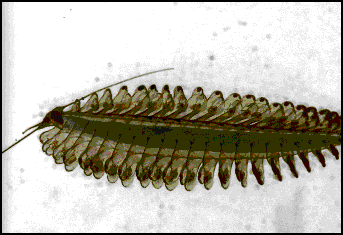Of the Deep
In Search of the
Sea's "Monsters" and
The World They Live In
Erich Hoyt
(Firefly)

Some of these guys get to be a couple of feet long, which is far better than the Lion's Mane Jellyfish which sports tentacles out to 120 feet and if you get tangled in those you'd be far better off betting your life on the Fantome in the middle of Hurricane Mitch.
Even worse is the viperfish which looks every bit like your nightmare of a deep-water monster: huge black googly staring eyes, teeth big enough to eat you with, my dear, and sort of a sickly pale orange-ish flesh- The absolute prize of the disgusting uglies will probably go to the Deep-Sea Anglerfish. It only grows up to a foot long, but god it's twelve inches of pure horror with little piggy-mean eyes, a huge lipless toothy mouth, an ugly "fishing pole" atop the mouth to lure the unsuspecting, and a wrinkled round reddish body that might be mistaken for an especially ugly Halloween pumpkin if it weren't heading straight for you for lunchtime which at that depth is anytime (since it's a place where the sun don't shine no more). Hoyt is a chatty and informative writer who is obviously crazy about the sea and its weirdness. He has divided the book into three parts. The first moves us down the five layers of the ocean. Then, we have the food chain --- going from plankton to whales and sharks. The final part has to do with the undersea mountains, such as the Mid-Atlantic Ridge which stretches for 46,000 miles, going as high as 15,000 feet, and would be great for climbing if it weren't several miles underwater. Creatures of the Deep has some seventy-five luscious photographs, including some that don't necessarily make you want to throw up, like the Marine Spider that looks like a Daddy Longlegs with class, a Portuguese man-of-
Creatures of the Deep has some seventy-five luscious photographs, including some that don't necessarily make you want to throw up, like the Marine Spider that looks like a Daddy Longlegs with class, a Portuguese man-of- The rift itself straddles the most active volcanoes in the world. More than 80 percent of the Earth's volcanic activity occurs here along the midocean ridge ... Every year, underwater volcanoes produce more than five cubic miles of lava --- a volume that would completely submerge an area the size of the United States and Canada under a foot (30 cm) of lava.
The rift itself straddles the most active volcanoes in the world. More than 80 percent of the Earth's volcanic activity occurs here along the midocean ridge ... Every year, underwater volcanoes produce more than five cubic miles of lava --- a volume that would completely submerge an area the size of the United States and Canada under a foot (30 cm) of lava.